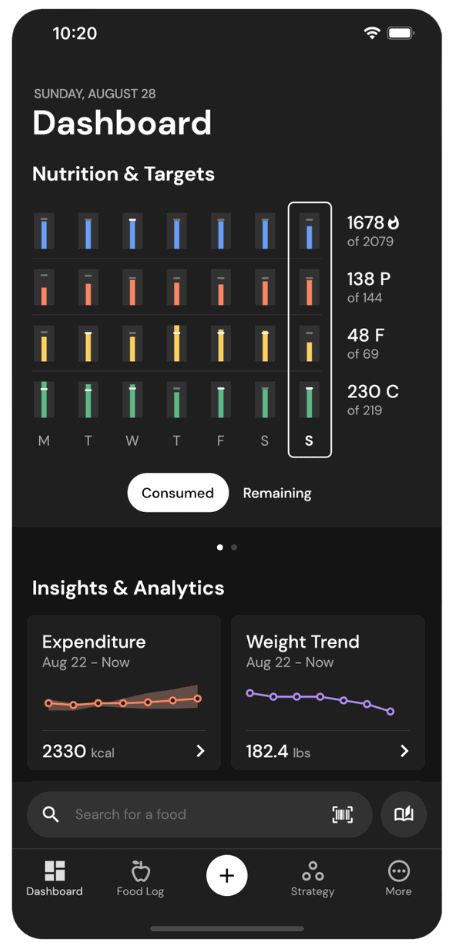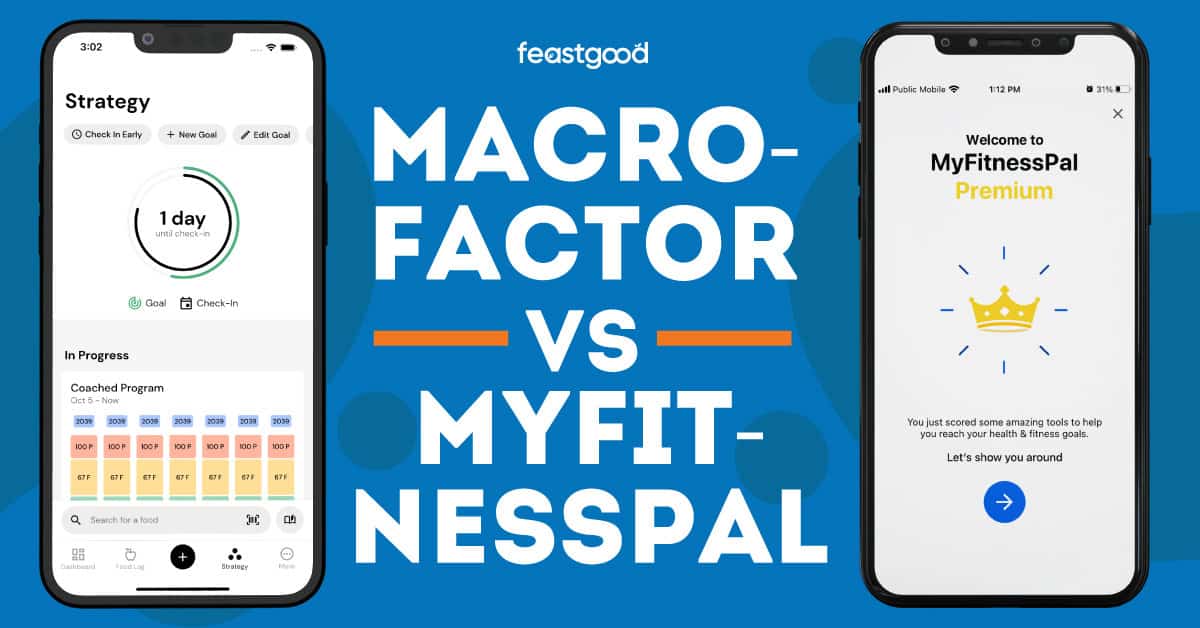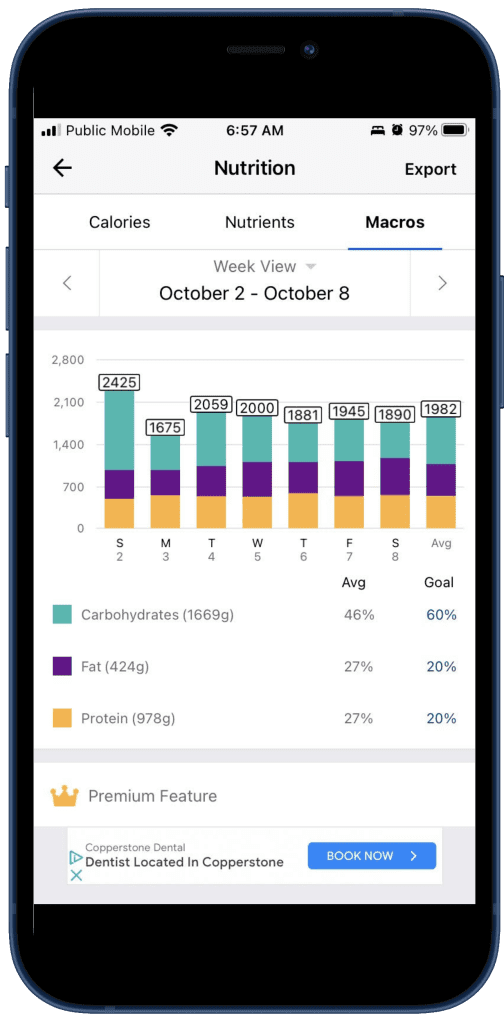Some links in this article are affiliate links, which means we earn from qualifying purchases. Learn more.
MyFitnessPal is the old-school macro-tracking app that’s been used by millions. MacroFactor is the new kid on the block, generating a ton of buzz in the last couple of years.
Our team of Nutrition Coaches and Registered Dietitians, including myself, have used both apps extensively and reviewed each independently. My colleague Amanda Parker has used Macrofactor for 1.5 years, and my other colleague, Lauren Graham, has used MyFitnessPal for over 3 years.
With our combined experience, I’ll compare and share which is better based on different goals/needs.
Key Takeaways
- The main difference between MacroFactor and MyFitnessPal is that MacroFactor serves as a built-in diet coach with dynamic recommendations based on user data. In contrast, MyFitnessPal is a basic calorie and macro tracking app with no coaching or ongoing recommendations.
- Macrofactor stands out for its large verified food database, customizable tracking features, intuitive adjustments based on user data, and emphasis on consistency over perfection. The app also continuously updates with scientific evidence. The downside? It lacks a free version (though you can get 2-weeks free using code FEASTGOOD).
- MyFitnessPal has a vast global food database and an intuitive interface. However, it declined in quality due to inaccurate food entries, intrusive ads on the free version, and many previously free features moved to the paid tier. Despite its popularity, better alternatives are available, especially for beginners.

Overall Rating: 4.8/5
MacroFactor

Overview
Features
Best For
*Enter code FEASTGOOD when signing up to get an extra week on your free trial (2 weeks total).

Overall Rating: 3.7/5
Medical Disclaimer: The content of this article is provided for educational insights only. It should not be used as medical guidance. Individuals with a past of disordered eating should refrain from weight loss programs or calorie tracking. For medical advice, consult a certified healthcare professional. If you’re struggling with eating disorders, contact NEDA for assistance.

What is MacroFactor?
MacroFactor is a nutrition-tracking app that doubles as a nutrition coach. Thanks to its sophisticated algorithms, the app analyzes users’ data and updates their nutritional targets to keep them on track with their goals.
Like many nutritional apps, MacroFactor asks basic questions about age, gender, and activity level; however, it also goes above and beyond to ask about lifting experience, cardio habits, and other nutritional preferences.
Based on the user’s information, the app recommends calorie and macro targets to adhere to for the upcoming week.
After a week of tracking, MacroFactor analyzes the data to ensure the targets produce the appropriate results based on your goal. If not, the app will update its targets.
The app’s recommendations become increasingly more accurate over time, so long as you diligently input the necessary data: body weight, calorie, and macronutrient intake.
What’s neat about MacroFactor is that its recommendations are grounded in the latest scientific findings and are updated regularly as new scientific literature emerges, which shouldn’t be a surprise, given the owners’ – Greg Nuckols and Jeff Nippard – backgrounds.
Another stand-out feature is the “AI describe” function to log your food, which allows you to log foods using dictation. This makes food logging much easier and is why MacroFactor has the fastest food logger on the market.
Pros
- Fastest food logger on the market
- Several ways to log food (including AI describe & barcode scanner)
- Encourages consistency over perfection for target adherence
- Ability to customize your nutrition preferences to suit your lifestyle
- Multiple coaching styles to choose from
- Weekly check-ins to adjust your nutritional targets based on your progress
Cons
- There is no free version of the app, only a 7-day free trial
- There is currently no desktop version of the app
MacroFactor App
It has a large verified food database, it’s the most customizable nutrition tracker on the market, it constantly adapts to your metabolism, it’s easy to use, and it’s upgraded regularly as new scientific evidence or suggestions are presented.
Enter code FEASTGOOD when signing up to get an extra week on your free trial (2 weeks total).
What is MyFitnessPal?
MyFitnessPal, launched over a decade ago, is perhaps the most popular and well-recognized calorie and macronutrient tracking app on the market. It’s known for its extensive food database and ease of use.
When MyFitnessPal hit the app store in 2009, it was a game-changer for those who wanted to start logging their food to work toward their health and fitness goals.
Nowadays, MyFitnessPal has some competition as other apps have emerged with similar (if not better) capabilities.
MyFitnessPal asks basic questions to estimate your nutritional needs and automatically calculates calories, protein, carbs, and fats. Then, users can log their food using its large database and work toward hitting the recommended targets.
The two major drawbacks to MyFitnessPal are 1) its database has tons of inaccurate entries that users need to look out for, and 2) its calorie recommendations tend to be lower than is recommended.
MyFitnessPal has a free version with enough features for users to track their nutrition. With the free version, you can update your calorie and macro targets to the nearest 5% but not the gram.
To access all the app’s features (including the barcode scanner) and to ditch the ads, you’ll have to pay for a premium membership.
Pros
- There is a decent free version with basic functions
- The food and recipe databases are quite extensive
- Users can log their nutrition in several ways (with the paid version)
- It integrates with other apps and fitness devices
Cons
- The free version is full of ads
- There are plenty of inaccurate entries in the food database
- Macro goal adjustment to the closest 5% instead of down to the gram (the free version)
MacroFactor vs. MyFitnessPal: Head To Head Comparison
To help identify which app is better than the other, I’ve compared them across the following 10 key criteria.
1. Food Database
MacroFactor
MacroFactor has a relatively large and accurate food database that makes it easier for users to pick food and beverage items from inside the app to log their nutrition with reasonable accuracy.
Users can feel confident that the foods they are logging are mostly accurate because all the entries in the database are verified.
Each food also has a detailed nutritional breakdown, including the amount of fibrous and starchy carbs, types of fats (and omega-3 fatty acids), protein (down to the individual amino acids), vitamins, minerals, alcohol, caffeine, and more.
MyFitnessPal
MyFitnessPal has arguably one of the biggest food databases available on the market. It’s been around for a long time, and users can freely contribute to the database as a form of crowdsourcing.
That said, their food database is notorious for its many inaccurate entries, which means users may be logging inaccurate foods, making it more difficult to reach their goals.
The inaccurate entries may not be a problem for experienced trackers who can tell when an entry is inaccurate, but beginners likely won’t know an inaccurate entry when they see it.
The Winner: MacroFactor
MacroFactor is the clear winner here. While it may not have as many food entries, each is far more accurate and has a complete nutritional breakdown.Clicking on a food item to inspect its nutritional value is a learning experience because you can learn about far more than the calories and macronutrients. The app breaks everything down, teaching you exactly what the food or beverage contains.
At the end of the day, users need a food database that they can trust and MacroFactor is much more reliable than MFP.
2. Tracking Capabilities
MacroFactor
MacroFactor allows users to track all the important nutritional metrics, including calories, protein, carbs, fats, vitamins, minerals, fiber, etc. Users can also log their physical activity, progress photos, body measurements, scale weight (and body fat percentage), and more.
The app can function as a simple macro tracker for casual users and an ultra-detailed nutritional tracker for those eager to dive into the nitty-gritty.
MyFitnessPal
MyFitnessPal users can track their calories, macronutrients, six micronutrients (sodium, potassium, calcium, iron, vitamins A and C), steps taken, exercise activity, body weight, body fat percentage, and several body measurements.
The Winner: MacroFactor
While MyFitnessPal allows users to track a few important metrics, MacroFactor is more detailed and lets users track all the data points they might care about.It also goes a step further by using this data to predict the user’s calorie expenditure (the number of calories they burn per day) and to provide a weight trend.
3. Calorie Recommendations
MacroFactor
MacroFactor asks new users about their gender, physical size, activity level, strength training experience, and cardio habits to calculate calorie and macronutrient targets. The app also allows users to tweak their preferred protein intake (e.g., high or moderate), weight loss rate, and more to ensure the targets are tailored to the user.
The initial nutritional recommendations are accurate, but it doesn’t end there. MacroFactor updates the user’s calorie and macronutrient targets based on input data. The app works like a nutrition coach, taking the guesswork out of the equation.
MyFitnessPal
MyFitnessPal asks basic questions to understand the user, including gender, age, physical size, and activity level, and then provides some nutritional recommendations (calories & macros) based on the user’s goal.
These recommendations are known to be lower than necessary, especially for those selecting “weight loss” as their goal.
However, the app does allow users to change their nutritional targets if they feel that those provided by the app are inaccurate. MFP does not update the targets for the user after the initial recommendation, so all changes must be made manually.
The Winner: MacroFactor
MacroFactor is the clear winner in this category because its initial recommendations are far more accurate, and they update over time to keep users on track with their goals.4. Level of Customization
MacroFactor
MacroFactor is deemed the most customizable macro tracker on the market because users can change almost everything they want.
The app allows users to change their calorie and macronutrient goals and shift their calorie intake daily.
For instance, you can eat more food one day, and the app will instantly re-calculate your nutritional targets for the rest of the week to accommodate the higher intake.
The app also allows users to set their preferred protein intake by choosing low, moderate, high, and extra-high. Similarly, users can select their desired weight loss rate, ranging from 0.1 to 1.5 percent of body weight weekly.
MyFitnessPal
MyFitnessPal does allow for some customization, mainly with its calorie and macronutrient targets.
However, users on the free version can only adjust their macronutrients to the closest 5% instead of down to specific grams. Apart from that, the app doesn’t offer much customization.
The Winner: MacroFactor
The beauty of MacroFactor is that users can customize most things inside the app or go with what the app recommends.In any case, there is plenty to play around with for those who like to experiment with their nutrition.
5. Educational Opportunities
MacroFactor
MacroFactor is not meant as an educational app because it doesn’t have daily lessons; however, the app is well designed for beginners by having detailed explanations of all its metrics and why they matter.
For instance, MacroFactor has a calorie floor feature, which represents the limit of how low the app’s calorie recommendations can get during a weight loss phase.
This educates users on the minimum number of calories they should eat while dieting. Without this feature, beginners may not know there is a limit to how low they can drop their calories without sacrificing their health.
MacroFactor also teaches people a lot about the nutritional composition of foods beyond calories and macronutrients. Those interested can dive into the nitty-gritty and learn about their favorite foods’ protein quality, micronutrients, and other details.
MyFitnessPal
MyFitnessPal is also not an educational app. However, it can give users some insight into nutrition by teaching them about the nutrient composition of different foods and what to eat to reach their calorie and macro goals.
The Winner: MacroFactor
While neither is classified as an educational app, we consider MacroFactor the winner in this category because it provides more in-depth nutritional data and explanations.The way it works makes it easier for people to understand how their body responds to changes in nutrition and energy expenditure over time.
6. Coaching
MacroFactor
MacroFactor is a macro-tracker that doubles as a nutrition coach. Users can pick from three coaching styles depending on how much control they want to have:
- Coached: where the app does all the thinking for you
- Collaborative: where it does the thinking for you, but users can override its recommendations
- Manual: where the user must adjust their nutrition on their own or with a coach
MyFitnessPal
The only coaching option for MyFitnessPal is for the user to share their food diary with their coach. Doing so would allow the coach to provide feedback and recommend client changes to keep them on track with their goals.
The Winner: MacroFactor
With its intuitive design and sophisticated algorithm, MacroFactor is an affordable and effective coaching solution for those who don’t have a nutrition coach. That said, It can also be used by those who do have a nutrition coach by choosing the “manual” option.7. Recipe Database
MacroFactor
MacroFactor has a recipe creator feature, allowing users to input and save their favorite recipes for later. However, the app doesn’t have a library where people can explore recipes.
MyFitnessPal
MyFitnessPal has a Recipe Discovery feature that allows users to find various recipes based on a category or hashtag. For instance, someone following a vegan diet can find multiple relevant and nutritious recipes inside the app by searching for vegan recipes.
The app also displays the nutritional information per serving for each recipe so users know how the recipe will affect their targets.
The Winner: MyFitnessPal
While MacroFactor allows users to log and store recipes, MyFitnessPal is the winner here because it has many recipes to explore with all the relevant nutritional information.8. Exercise Calories
MacroFactor
MacroFactor will ask you about your activity level and exercise habits during sign-up to better understand your nutritional needs.
It also integrates with Fitbit devices, which combine your BMR (the calories your body expends to keep you alive) and activity level to calculate your total caloric expenditure.
That said, MacroFactor generally doesn’t change your nutritional targets, especially in response to one-off bursts of activity (say, going hiking one day). It analyzes other data, such as your body weight and fat percentage, to update its recommendations as necessary.
MyFitnessPal
MyFitnessPal lets users log their physical activity and based on this activity, it estimates the caloric expenditure and allows users to ignore it or add it back to their daily total. Adding the calories back in is the default setting, so you must turn this feature off.
For instance, if you go hiking on Sunday and burn 500 calories, the app will add the burned calories to your daily target (+500 cal).
Those who are trying to maintain or gain weight should add calories burned back to their intake; however, those who are dieting should turn this feature off to make it easier to lose weight.
The issue is that many beginners trying to lose weight may not realize the app is adding calories burned back to their daily targets.
The Winner: MacroFactor
Despite MyFitnessPal allowing users to control whether these calories are added back in or excluded from targets, MacroFactor wins this category.Instead of reacting to daily fluctuations in energy expenditure, MacroFactor looks at your activity level as a whole and couples the data with other metrics to determine when and how to update your nutritional targets. This takes the guesswork out of the equation and makes it more streamlined for users.
9. Price
MacroFactor
MacroFactor offers a free 7-day trial. After the trial, users will have to pick from three subscription options:
- $11.99 per month
- $47.99 for half a year (comes out at $7.99 per month)
- $71.99 for a year (comes out at $5.99 per month)
MyFitnessPal
MyFitnessPal has a free basic version of the app or a premium version. For those wanting to try the premium version before committing, there is a 30-day free trial. Beyond that, it costs:
- $19.99 per month
- $79.99 for a year (comes out at $6.66 per month)
The Winner: MacroFactor
Although MyFitnessPal has a free version of the app, users agree that the free version is frustrating and slow because of the amount of ads that appear. For this reason and many others, premium is the way to go.When comparing the premium version of MFP and MacroFactor, it’s clear that MacroFactor is the winner as all of its plans cost less than MyFitnessPal, and it has a half-year plan.
The only advantage of MFP over MF is that its free trial is 30 days, as opposed to MacroFactor’s 7-day one.
10. Reviews
MacroFactor
MacroFactor has a modest 4.6-star rating with close to 1,900 reviews on Google Play and 4.7 stars with 1,200+ reviews on the App Store.
MyFitnessPal
MyFitnessPal has a 4.1-star rating with 2.6+ million reviews on Google Play and 4.7 stars with 1.7+ million reviews on the App Store.
The Winner: MyFitnessPal
MyFitnessPal wins this category mainly because it’s been around longer and has an impressive 4.7-star rating on the App Store.Its 4.1-star rating on Google Play is also noteworthy, but the worrisome part is that it’s dipped by 0.6 stars since November 2022, which is huge for an app with that many reviews.
MacroFactor has the potential to surpass MyFitnessPal eventually, but it’s simply too new to contend in this category now.
Who Should Use MacroFactor?
MacroFactor is ideal for people who:
- Want built-in coaching capabilities
- Value an app based on recent scientific findings
- Prefer a sustainable nutritional approach that doesn’t require perfection
- Want to track various things, including body measurements and body fat, all in one app
Who Should Use MyFitnessPal?
MyFitnessPal is great for those who:
- Have experience in macro-tracking and can spot inaccuracies in the food database
- Frequently eat meals at restaurants and want a simple way to log them
- Prefer a global database for easy food logging while traveling
MacroFactor vs. MyFitnessPal: Quick Overview
| MacroFactor | MyFitnessPal | Our Interpretation | |
|---|---|---|---|
| Food Database | MacroFactor’s food database is relatively large and verified, making it more accurate. | MyFitnessPal’s database is huge, with millions of entries, but it is known for many inaccuracies. | MacroFactor is the winner because entries are more accurate on average, and the nutritional breakdown is far more detailed. |
| Tracking Capabilities | • Calories • Macronutrients • Vitamins • Minerals • Fiber • Activity level • Progress photos • Circumference measures • Body weight • Body fat • Weight trend | • Calories • Macronutrients • 6 vitamins and minerals • Exercise activity • Steps taken • Circumference measures | MacroFactor is far more detailed and allows users to track important data points. |
| Calorie Recommendations | MacroFactor provides accurate nutritional targets and continually updates its recommendations based on the data users input. | MyFitnessPal’s nutritional recommendations are somewhat low, and it doesn’t update them over time. | MacroFactor is better because it’s more accurate and updates your targets based on weight trends and other factors. |
| Level of Customization | MacroFactor allows users to customize their nutritional targets, minimum calorie recommendations, weight loss rate, preferred protein intake, and more. | MyFitnessPal allows users to override the app’s nutritional recommendations but not much else. | MacroFactor is better because it can work as a nutrition coach, but it also allows users to adjust things based on their preferences. |
| Educational Opportunities | The app is not meant to be an educational resource, but it does an excellent job breaking down foods, weight loss rates, protein intake, etc. | MyFitnessPal doesn’t educate users on proper eating or making dietary changes. It can teach people about the nutritional value of foods, which can be useful. | MacroFactor gives users more opportunities to learn about important fitness and nutrition concepts and how their body is responding over time. |
| Coaching | MacroFactor has a Coached option, where users give up control and allow the app to provide recommendations and adjust them based on the user’s progress. | MyFitnessPal users can share their food diary with their coach, which could be beneficial. | MacroFactor is better because it can double as a nutrition coach, eliminating guesswork for users. |
| Recipe Database | MacroFactor doesn’t have a recipe database. Users can only input and store their own recipes in the app. | MyFitnessPal has a large recipe database, complete with nutritional information. | MyFitnessPal is better in this category because users can easily find recipes for inspiration. |
| Exercise Calories | MacroFactor doesn’t generally place great emphasis on exercise calories. Instead, it looks at users’ overall activity level, calorie intake, weight trends, and other factors to update its recommendations. | MyFitnessPal can track exercise calories. It allows users to ignore or add them to their daily total by turning this feature on or off. | MacroFactor is more intuitive and less reactive. Its sophisticated algorithm accounts for multiple things to make relevant and accurate recommendations. |
| Price | 7-day free trial. Then: • $11.99 per month • $47.99 for half a year (comes out at $7.99 per month) • $71.99 for a year (comes out at $5.99 per month) | Free version or 30-day free trial. Then: • $19.99 per month • $79.99 for a year (comes out at $6.66 per month) | MacroFactor is more affordable and has a half-year plan. MyFitnessPal’s only advantage is that its free trial is 30 days. |
| Reviews | It has a 4.6-star rating with just over 1,800 reviews on Google Play and 4.7 stars with 1,200+ reviews on the App Store | It has a 4.1-star rating with 2.6+ million reviews on Google Play and 4.7 stars with 1.7+ million reviews on the App Store. | MyFitnessPal is more established and wins the reviews category. |
Other App Comparisons
Check out our other app comparisons with MacroFactor and MyFitnessPal:
- MyFitnessPal vs Cronometer
- MyFitnessPal vs RP Diet
- MyFitnessPal vs Noom
- MacroFactor vs Cronometer
- Lifesum vs MyFitnessPal
- MacroFactor vs RP Diet
About The Author

Philip Stefanov is a certified conditioning coach, personal trainer, and fitness instructor. With more than nine years of experience in the industry, he’s helped hundreds of clients improve their nutritional habits, become more consistent with exercise, lose weight in a sustainable way, and build muscle through strength training. He is passionate about writing and has published more than 500 articles on various topics related to healthy nutrition, dieting, calorie and macronutrient tracking, meal planning, fitness and health supplementation, best training practices, and muscle recovery.
Why Trust Our Content

On Staff at FeastGood.com, we have Registered Dietitians, coaches with PhDs in Human Nutrition, and internationally ranked athletes who contribute to our editorial process. This includes research, writing, editing, fact-checking, and product testing/reviews. At a bare minimum, all authors must be certified nutrition coaches by either the National Academy of Sports Medicine, International Sport Sciences Association, or Precision Nutrition. Learn more about our team here.
Have a Question?
If you have any questions or feedback about what you’ve read, you can reach out to us at [email protected]. We respond to every email within 1 business day.

